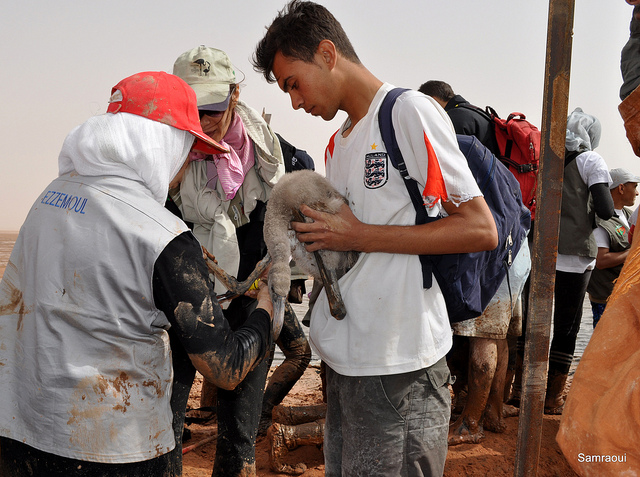On 24 April, Sebkhat Sefioune was officially recognised by the scientific community as the earliest greater flamingo breeding site in the Mediterranean. 62 chicks were ringed by the research teals of the Wetlands Research Laboratory of Guelma and Ouargla Universities. A success story in the making.
 This is far from being the first ringing operation in Algeria, but it is the first time that the greater flamingo has bred so early. Until now, the various ringing operations carried out in the Mediterranean have not started until June. It is thus a real scientific exploit, in the face of very difficult conditions, achieved by the research teams led by Prof. Samraoui, head of the Guelma University Wetlands Research Laboratory. The volunteers had to deal with a violent sandstorm, cold temperatures and logistical difficulties, but despite it all 62 greater flaming chicks will henceforward be sporting yellow Algerian rings with a black code.
This is far from being the first ringing operation in Algeria, but it is the first time that the greater flamingo has bred so early. Until now, the various ringing operations carried out in the Mediterranean have not started until June. It is thus a real scientific exploit, in the face of very difficult conditions, achieved by the research teams led by Prof. Samraoui, head of the Guelma University Wetlands Research Laboratory. The volunteers had to deal with a violent sandstorm, cold temperatures and logistical difficulties, but despite it all 62 greater flaming chicks will henceforward be sporting yellow Algerian rings with a black code.
The story began in 2009 41 km from Ouargla. Sebkhat Séfioune is a drainage area for several wadis coming from the central Sahara and northern Algeria. It had completely dried out but was resuscitated by the implementation of a canal draining domestic and agricultural water from the Ouargla basin. Nowadays the site is full of life, of biodiversity, of birdsong…. The Sefioune Lake now shelters a thousand greater flamingos and large numbers of teal, black-winged stilt, avocet and sandpiper, together with various insects and other forms of aquatic wildlife. The vegetation is also abundant, in contrast with the surrounding desert landscape.
The change did not escape the notice of the flamingos which, having spotted the site in 2009, returned in 2010 to nest. They were monitored by researchers from Ouargla and Guelma, who as from December 2010 were able to observe their nuptial displays, nesting and the birth of their chicks.